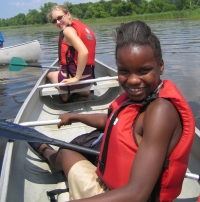Physicians like Dr. Miller are “prescribing” time out in nature as a part of a healthy lifestyle. Makes sense, right? Humans are an integral part of the ecosystem and our health is tied to it.
Get active outdoors/feel better is something many of us have experienced. Here at the Urban Ecology Center, our core mission is to help people of all ages develop an ecological understanding which inspires them to make changes that result in a healthy environment, now and into the future. We believe that our health is tied to the health of the ecosystem. We know this, but how can we measure it?
We kicked off 2012 with a project to measure the Center’s impact on public health. Through the Healthier Wisconsin Partnership Program, over the next two years we will be studying how our programs, specifically the ones at our Menomonee Valley branch, influence positive lifestyle changes. As we close the first year of the project, we’d like to share some highlights of the Center’s work related to community health.
Active lifestyles
According to the Center for Disease Control, childhood obesity rates have tripled in the last 30 years and over two thirds of adults are overweight or obese. Exercise combined with good nutrition can combat these issues and prevent the numerous, expensive health issues associated with obesity. The Urban Ecology Center combats obesity and indoor sickness through year-round outdoor programs that introduce or improve recreation skills and safety, as well as an equipment sharing program that supports outdoor activities independent from programs at the Center.
Last year over 1000 children and 500 adults participated in boating education programs at the Center. Most of these programs were aimed at beginners, and helped to develop physical balance and strength, as well as interest in outdoor play. Combining all of our outdoor recreation programs, which includes rock climbing, hiking, skiing and snowshoeing, over 6000 children and 1100 adults were taught how to enjoy these activities safely. Plus, all of the 23,000+ participants in our school partnership program take a walk outside during their program.
Once participants gain an appreciation of these outdoor activities, the Center’s equipment lending program makes them affordable for families. We have provided members over 4000 tents, canoes, backpacks, bicycles, skis, snowshoes, tennis rackets, kayaks, lawn games and gardening equipment in one year! In the Menomonee Valley, where we just opened our doors, the community health study measures both how much time children spend playing outdoors and if their attitudes toward outdoor play will change because of our work there.
Nutrition
On September 18th, the Milwaukee Journal Sentinel displayed a photo of a program where
children were about to taste vegetables which had been growing in their garden moments ago. Every week, the Young Scientists Club in Washington Park hosts Food Fridays, where students grow, harvest, prepare and eat vegetables from their gardens throughout the year. Food Fridays is fun, delicious and nutritious. With the launch of our new program database and website this past summer, it is now possible to search for our food programs, which last year had over 4000 participants, nearly 50% of which were kids. Food programs focus on fresh, local and healthy foods such as the one highlighted by the Milwaukee Journal Sentinel.
Emotional health
Community health is not just about physical well-being; it also encompasses emotional and mental health. Our literature reviews show that people who have exposure to nature tend to also have less stress, aggression and anxiety. To get a sense of stress and aggression in
the community, over 150 hours of volunteer time was spent walking the neighborhood looking and listening for indicators, such as arguments, aggressive driving or disheveled homes or yards. Our hope is to see decreases in these indicators over time.
Delinquency
Neighborhoods that are stressed also tend to have an uptick in delinquent behaviors such as theft and vandalism. As we move forward with the health study, we hope to see decreases in graffiti, littering, broken windows and evidence of illegal drug and alcohol use. While we do not yet have statistics, we do have stories, and here are two of them:
In June, students who were setting a rocky ambush for bicyclists on the s-curve trail that extends from the Hank Aaron State Trail into the Silver City neighborhood were invited inside so that these same rocks could be added to a beautiful mural that is now a permanent fixture of our Menomonee Valley branch. They not only cleaned up the trail, making safe passage for bicyclers, but they were able to engage in an activity that benefited their community.
In September, a couple of visitors had bikes stolen while visiting the Center. Using our security equipment, we found that the thieves were youth familiar to our staff. We were then able to engage the youth’s entire family in righting the wrong and learning about what it means to be part of an engaged, healthy community. These two small examples of what positive engagement with adults can do to help youth understand their own influence in bettering their community.
Exercise, nutrition, emotional well-being and lawfulness are just some of the components that lead to a healthier community. We invite you to become engaged in this important work, as learners, supporters, volunteers and members. As a community we can combat “indoor sickness” and improve community health. So, let’s all get outside and play… doctor’s orders!





